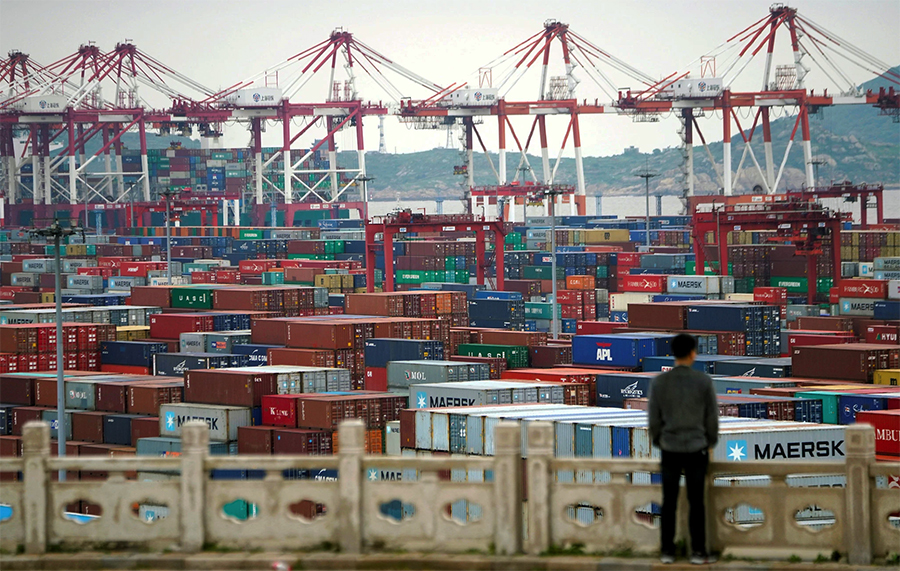Industry and retail trade organizations reacted quickly to criticize President Trump’s plans for a new 10 percent tariff on $300 billion of Chinese imports, taking effect on Sept. 1, 2019. These tariffs will target “List 4” products – products including footwear and apparel that have not previously been subject to tariff increases.
The president revealed the news in a tweet, “Trade talks are continuing, and during the talks the U.S. will start, on September 1st, putting a small additional tariff of 10% on the remaining 300 billion dollars of products coming from China into our country,”
He added, “We look forward to continuing our positive dialogue with China on a comprehensive Trade Deal, and feel that the future between our two countries will be a very bright one!”
The surprise tariff announcement came after the U.S. and China restarted trade talks in Shanghai this week. The White House said the meetings were “constructive,” adding China confirmed their commitment to increase purchases of U.S. agricultural exports. Trade negotiations will continue in Washington in early September, according to the White House statement.
The US Trade Representative’s office in June completed the legal steps required for imposing a 25 percent tariff on $300 billion imports of goods from China. Trump delayed their imposition following a June 29 meeting with Chinese president Xi Jinping.
On Thursday, the Dow Jones Industrial Average plunged as much as 304 points Thursday following the news, erasing the 311-point gains earlier in the day.
The U.S. Trade Representative has not yet released the final list by product category. There is a possibility that certain products will be removed from this list, following the public comments and hearing process in June, in which industry groups advocated for their members’ petitions.
Several industry groups expressed disappointment with the move.
At the OIA (Outdoor Industry Association), Patricia Rojas-Ungar, VP of government affairs, said in a statement, “This so-called ‘small’ tariff is anything but. If this ‘small’ tariff had been in place in May, it would have cost outdoor businesses more than $700 million in new tariffs. The hard-working Americans in the outdoor industry have already shouldered an extra $1.25 billion in tariffs from the previous round imposed in September 2018. These ‘taxes’ should instead be going back into creating more jobs, developing new products and expanding facilities and businesses. Instead, the Administration’s trade agenda will hurt outdoor companies, particularly small and medium-sized businesses, and burden our communities further. We need a comprehensive trade deal between the United States and China and we need it now.”
“We are disappointed with the President’s action to escalate this trade war,” stated SFIA (Sports & Fitness Industry Association) president and CEO, Tom Cove. “The announcement of the tariff truce between President Trump and President Xi gave us hope that the two nations would continue negotiations in a positive way that would not harm American consumers and corporations. While we see protecting intellectual property as critically important to global commerce, tariffs are not the solution to the problem and the American economy
will suffer.”
SFIA’s statement said the organization will continue to discourage the president from increasing import duties on Chinese products, “as China serves a crucial manufacturing role for many American companies.” As more information is provided regarding the final list to face the 10 percent tariff, SFIA will inform all interested and affected parties.
The surprise tariff announcement came after the U.S. and China restarted trade talks in Shanghai this week. The White House said the meetings were “constructive,” adding China confirmed their commitment to increase purchases of U.S. agricultural exports.
Nick Sargent, president, Snowsports Industries America, said in a statement: “Make no mistake, this is a tax on US consumers and it’s become more real by the day. This knee jerk diplomacy has severe implications for our manufacturers who will most likely try to absorb the costs in the short term, wiping out any margins they may have had, but also across our retail network and their consumers who will have to deal with unrealistic price increases. Our main selling season begins soon and if we’re going to grow as an industry, these tariffs have to be rescinded. SIA is working hard to let our lawmakers know that these decisions are not in the best interest of the snow sports industry and American business.”
FDRA (Footwear Distributors and Retailers of America) President and CEO Matt Priest said in a statement: “We are dismayed at President Trump’s announcement that he is adding 10 percent tariffs on the remaining $300 billion in imported goods from China on September 1st. FDRA has worked tirelessly to make the case against even higher tariffs on shoes. We hoped that continued open communication channels between Washington and Beijing would allow time to ease trade tensions and eventually end the tariff threat. It is clear political considerations are outweighing economic common sense, especially as this comes on the heels of a rate drop by the Federal Reserve indicating more challenging economic times ahead.
“President Trump’s new tariffs should concern every American. 70 percent of every pair of shoes sold in the U.S. comes from China. Footwear from China is already hit with upwards of 67 percent duties. President Trump is, in effect, using American families as a hostage in his trade war negotiations. Tariffs are taxes and this move will noticeably raise the cost of shoes at retail and will have a chilling effect on hiring in the footwear industry.
“We will not take this news lying down. This is one of the largest tax increases in American history and it is vitally important that we fight this action on behalf of our consumers and our industry.”
“Tariffs are taxes on American consumers. The President’s decision to proceed with adding these additional costs for hard-working American families is truly shocking,” said Rick Helfenbein, president and CEO of the American Apparel & Footwear Association (AAFA). “This decision will increase the tariff bill on all clothes, shoes, and home textiles, like blankets and sheets – products that already account for the vast majority of the duties collected by the U.S. government. The fact that this tweet comes after only one meeting with the Chinese delegation following the resumption of talks is extremely concerning. It is time for Congress to step up and take back its authority to manage international trade as outlined under the U.S. Constitution.”
The AAFA said the list of products, which was under a public comment period in June, includes all imports of apparel and footwear products. In 2018, 42 percent of apparel and 69 percent of footwear sold in the U.S. was imported from China. The punitive tariff would be added on top of the tariffs already imposed on these products – in 2017, 51 percent of the duties collected by the U.S. government came from the apparel, footwear, textiles, and travel goods industry, despite accounting for only 6 percent of all imports. Most textiles, all travel goods, and many accessories are currently being hit with a 25 percent additional tariff as part of previous steps taken by the administration in the trade conflict with China.
The National Retail Federation today issued the following statement from Senior Vice President for Government Relations David French in response to the Trump administration’s plans to impose a 10 percent tariff on $300 billion worth of goods imported from China beginning September 1.
“As we’ve said repeatedly, we support the administration’s goal of restructuring the U.S.-China trade relationship,” said David French, SVP for government relations at the National Retail Federation (NRF). “But we are disappointed the administration is doubling-down on a flawed tariff strategy that is already slowing U.S. economic growth, creating uncertainty and discouraging investment. These additional tariffs will only threaten U.S. jobs and raise costs for American families on everyday goods.
French added, “The tariffs imposed over the past year haven’t worked, and there’s no evidence another tax increase on American businesses and consumers will yield new results. We urge the administration to bring our allies to the table and find new tools beyond tariffs to achieve better trade relations.”
Hun Quach, VP of international trade at Retail Industry Leaders Association (RILA), said in a statement, “The list of products these tariffs will hit is almost entirely consumer-oriented. This new 10% tariff on Chinese imports is a direct hit on consumer products and family budgets, plain and simple.
“Tariffs are taxes on American consumers. And if these tariffs happen, American consumers will bear the brunt of these tactics via higher prices on everyday items like clothing, toys, home goods, and electronics.
“American families shouldn’t be a pawn in this trade war. Retailers, consumers, and American workers need this Administration to find a path forward that results in a fair agreement. Today’s announcement only moves us closer to consumers bearing the brunt of the pain.”
Gary Shapiro, president and CEO, Consumer Technology Association (CTA), said, “Retaliatory tariffs, whether 10% or 25%, are bad policy. The Trump administration is again taxing the American people in the form of new tariffs on their favorite technology products. Tariffs are taxes paid for by U.S. consumers, not China’s government. These retaliatory tariffs are not effective trade policy and may violate U.S. law.
“Over 300 companies and business associations came to Washington this summer to plead with the administration to stop tariffs. And over 600 businesses of all sizes across the country sent a letter to President Trump opposing tariffs. President Trump should stop ignoring America’s job creators and workers and remove tariffs to prevent higher costs to American families and businesses.”
CTA’s statement noted that the U.S. technology industry paid $1.3 billion in Section 301 tariffs imported on Chinese products in May, according to the latest available data, an amount that will likely rise in the coming months as a result of the last tariff hike to 25 percent on List 3 products.
Photo courtesy Reuters
















